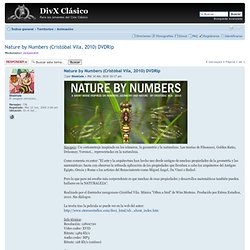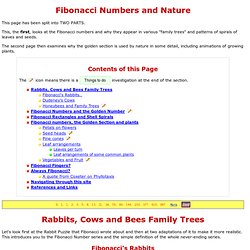

Nature by Numbers (Cristóbal Vila, 2010) DVDRip. Sinopsis: Un cortometraje inspirado en los números, la geometría y la naturaleza.

Las teorías de Fibonacci, Golden Ratio, Delaunay, Voronoi… representadas en la naturaleza. Como comenta su autor: "El arte y la arquitectura han hecho uso desde antiguo de muchas propiedades de la geometría y las matemáticas: basta con observar la refinada aplicación de las propiedades que llevaban a cabo los arquitectos del Antiguo Egipto, Grecia y Roma o los artistas del Renacimiento como Miguel Ángel, Da Vinci o Rafael. Pero lo que para mí resulta más sorprendente es que muchas de esas propiedades y desarrollos matemáticos también pueden hallarse en la NATURALEZA". Realizado por el ilustrador zaragozano Cristóbal Vila.
Música "Often a bird" de Wim Mertens. La teoría tras la película se puede ver en la web del autor: Info técnica:Resolución: 1280x720Video codec: XVIDBitrate: 1489 Kb/sAudio codec: MP3Bitrate: 128 Kb/s (estéreo) Capturas: Nature by Numbers - Video. Making Sense Of Maths » Fibonacci. A series of numbers that are frequently found in nature are called They are named after a famous Mathematician and Philosopher from the 12th Century. Leonardo of Pisa was from the family, hence the name Fibonacci. The numbers are … Each number in the series is made by adding the two previous numbers in the sequence. ( why the shell? ) Have you ever noticed that most flowers have 5 petals, …or 3 petals ? And , have 3 portions in their fruit, , has 5 compartments, and an forms a star when cut sideways. is formed when the larger of two consecutive Fibonacci is divided by the smaller giving the number as approximately e.g. 13 / 8 = 1.625 Many things in nature and art (e.g. the Mona Lisa) are formed in the ratio of and it is believed that shapes which are ” pleasing to the eye ” are formed according to this ratio.
The ratio is also frequently found in music, architecture, art, biology etc. The Golden Ratio in Nature" You won't find Fibonacci numbers everywhere in the natural world -- many plants and animals express different number sequences.

And just because a series of numbers can be applied to an object, that doesn't necessarily imply there's any correlation between figures and reality. As with numerological superstitions such as famous people dying in sets of three, sometimes a coincidence is just a coincidence. But, Fibonacci numbers appear in nature often enough to prove that they reflect some naturally occurring patterns. The Fibonacci Numbers and Golden section in Nature - 1. This page has been split into TWO PARTS.

This, the first, looks at the Fibonacci numbers and why they appear in various "family trees" and patterns of spirals of leaves and seeds. The second page then examines why the golden section is used by nature in some detail, including animations of growing plants. Let's look first at the Rabbit Puzzle that Fibonacci wrote about and then at two adaptations of it to make it more realistic. This introduces you to the Fibonacci Number series and the simple definition of the whole never-ending series. Fibonacci's Rabbits The original problem that Fibonacci investigated (in the year 1202) was about how fast rabbits could breed in ideal circumstances.
Suppose a newly-born pair of rabbits, one male, one female, are put in a field. How many pairs will there be in one year? At the end of the first month, they mate, but there is still one only 1 pair. The number of pairs of rabbits in the field at the start of each month is 1, 1, 2, 3, 5, 8, 13, 21, 34, ... . SEDIN - NOTAS y RESEÑAS: Los patrones de las plantas siguen causando desconcierto. El Número de Oro; Phi; la Divina Proporción.